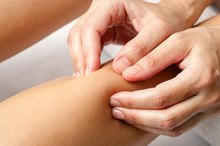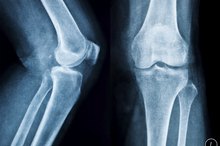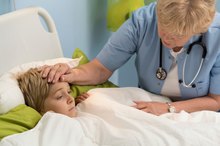What Causes Fluid in the Hip Joint?
The hip joint contains bones, tendons, muscles, ligaments and fluid filled sacs called bursa. It is a ball and socket joint that allows the leg to be lifted out to the side, to the front, to the back, and it also allows a small amount of rotation. The structures within the hip joint can become inflamed due to injury or disease, which can cause a buildup of fluid in the hip. If this occurs, it is important to get a proper diagnosis, as different conditions call for different treatment approaches.
If you are experiencing serious medical symptoms, seek emergency treatment immediately.
Arthritis
Like any joint in the body, the hip joint can develop arthritis. The two most common forms that occur in the hip are osteoarthritis and rheumatoid arthritis. Osteoarthritis occurs when the cartilage in the joint wears away and the bones rub against each other. Rheumatoid arthritis is an autoimmune condition in which the synovial lining of the joint becomes inflamed.
Both of these conditions can cause pain, stiffness and a buildup of fluid in the hip, states the American Academy of Orthopaedic Surgeons 1. X-rays and MRIs can help detect any excess fluid and a physician may need to aspirate some of the fluid to test for disease.
- Like any joint in the body, the hip joint can develop arthritis.
- Rheumatoid arthritis is an autoimmune condition in which the synovial lining of the joint becomes inflamed.
Bursitis
Leg, Ball & Socket Pain
Learn More
The bursa or fluid filled sacs located within the hip joint, help to provide lubrication and cushioning. However, overuse of the hip area can cause these sacs to become inflamed leading to bursitis, warns MayoClinic.com. Along with fluid accumulation in the joint, there may be pain, stiffness, redness and swelling. This condition can be diagnosed during a physical exam, although other tests may be run to rule out other causes.
- The bursa or fluid filled sacs located within the hip joint, help to provide lubrication and cushioning.
Infection
When an infection occurs in the body, the immune system responds in part by causing swelling or a build up of fluid in the affected area. This can happen anywhere in the body, including the hip joint. Infections can occur after surgery, such as a hip replacement, or when bacteria enter the joint through a cut. Infections that start somewhere else in the body that are left untreated, can travel through the bloodstream and enter the hip joint. An infection requires treatment with antibiotics and in severe cases, surgery may be required.
- When an infection occurs in the body, the immune system responds in part by causing swelling or a build up of fluid in the affected area.
- Infections can occur after surgery, such as a hip replacement, or when bacteria enter the joint through a cut.
Osteonecrosis
Causes of Pain in the Upper Left Hip
Learn More
Osteonecrosis is a condition in which the bones do not receive an adequate supply of blood, which causes them to break down. The exact cause of this condition remains unknown; however, the risk is higher in those with inflammatory diseases or who have received treatment for cancer. This condition can also occur in the absence of disease and the hip joint is a common site.
According to the National Institute of Arthritis and Musculoskeletal and Skin Diseases, treatment is required to help prevent permanent disability and it will usually include medications to help reduce swelling in the joint 4. It may be necessary to refrain from weight bearing on the affected hip while it is healing, along with receiving other treatments to help stimulate bone growth.
- Osteonecrosis is a condition in which the bones do not receive an adequate supply of blood, which causes them to break down.
- According to the National Institute of Arthritis and Musculoskeletal and Skin Diseases, treatment is required to help prevent permanent disability and it will usually include medications to help reduce swelling in the joint 4.
Related Articles
References
- American Academy of Orthopaedic Surgeons: Inflammatory Arthritis of the Hip
- Mayo Clinic: Bursitis Causes
- Merck: Infectious Arthritis
- National Institute of Arthritis and Musculoskeletal and Skin Diseases: Osteonecrosis
- Gladman DD, Ritchlin C. Patient education: Psoriatic arthritis (Beyond the basics). UpToDate. Updated February 5, 2018.
- Docken WP. Clinical manifestations and diagnosis of polymyalgia rheumatica. UpToDate. Updated October 8, 2019.
- Goldenberg DL. Patient education: Fibromyalgia (Beyond the basics). UpToDate. Updated June 21, 2018.
- Centers for Disease Control and Prevention. Osteoarthritis (OA). Updated January 10, 2019.
- MedlinePlus. Osteoarthritis. Updated January 6, 2020.
- Banks SE. Erosive osteoarthritis: a current review of a clinical challenge. Clin Rheumatol. 2010;29(7):697-706. doi:10.1007/s10067-009-1369-7
- Engel B, Just J, Bleckwenn M, Weckbecker K. Treatment options for gout. Dtsch Arztebl Int. 2017;114(13):215-222. doi:10.3238/arztebl.2017.0215
- MacMullan P, McCarthy G. Treatment and management of pseudogout: insights for the clinician. Ther Adv Musculoskelet Dis. 2011;4(2):121-131. doi:10.1177/1759720x11432559
- Arthritis Foundation. Infectious arthritis.
- Marks M, Marks JL. Viral arthritis. Clin Med (Lond). 2016;16(2):129-134. doi:10.7861/clinmedicine.16-2-129
- Sierakowski S, Cutolo M. Morning symptoms in rheumatoid arthritis: a defining characteristic and marker of active disease. Scand J Rheumatol. 2011;40(sup125):1-5. doi:10.3109/03009742.2011.566433
- Spondylitis Association of America. Overview of types of spondylitis.
- National Psoriasis Foundation. Psoriatic arthritis. Updated December 28, 2018.
- Gladman DD, Ritchlin C. Patient education: Psoriatic arthritis (Beyond the basics). Updated February 5, 2018.
- National Organization for Rare Disorders. Reactive Arthritis.
- Arvikar SL, Fisher MC. Inflammatory bowel disease associated arthropathy. Curr Rev Musculoskelet Med. 2011;4(3):123-131. doi:10.1007/s12178-011-9085-8
- Lam NC, Ghetu MV, Bieniek ML. Systemic lupus erythematosus: Primary care approach to diagnosis and management. Am Fam Physician. 2016;94(4):284-94.
- Docken WP. Clinical manifestations and diagnosis of polymyalgia rheumatica. Updated October 8, 2019.
- Goldenberg DL. Patient education: Fibromyalgia (Beyond the basics). Updated June 21, 2018.
- National Institute of Diabetes and Digestive and Kidney Diseases. Hashimoto's disease. Updated September 2017.
- Jaracz J, Gattner K, Jaracz K, Górna K. Unexplained painful physical symptoms in patients with major depressive disorder: Prevalence, pathophysiology and management. CNS Drugs. 2016;30(4):293-304. doi:10.1007/s40263-016-0328-5
- Solmaz D, Bakirci S, Kimyon G, et al. The impact of having family history of psoriasis or psoriatic arthritis on psoriatic disease. Arthritis Care Res (Hoboken). 2020;72(1):63-68. doi:10.1002/acr.23836
- Fouladbakhsh J. Complementary and alternative modalities to relieve osteoarthritis symptoms: A review of the evidence on several therapies often used for osteoarthritis management. Orthop Nurs. 2012;31(2):115-121. doi:10.1097/nor.0b013e31824fce6e
- Wandel S, Jüni P, Tendal B, et al. Effects of glucosamine, chondroitin, or placebo in patients with osteoarthritis of hip or knee: network meta-analysis. BMJ. 2010;341:c4675. doi:10.1136/bmj.c4675
- American Academy of Orthopaedic Surgeons. Osteotomy of the knee. Updated June 2017.
- Marks M, Marks JL. Viral arthritis. Clin Med (Lond). 2016 Apr;16(2):129-34. doi:10.7861/clinmedicine.16-2-129
- Pujalte G, Albano-Aluquin SA. Differential Diagnosis of Polyarticular Arthritis. Am Fam Physician. 2015 Jul 1;92(1):35-41.
- Shmerling RH. (2017). Evaluation of the adult with polyarticular pain. Maini RN, ed. UpToDate. Waltham, MA: UpToDate Inc.
- Skou ST, Roos EM, Laursen MB, et al. A Randomized, Controlled Trial of Total Knee Replacement. N Engl J Med. 2015;373(17):1597-1606. doi:10.1056/NEJMoa1505467
Writer Bio
I hold a Master's degree in exercise physiology/health promotion. I am a certified fitness specialist through the American College of Spots Medicine and an IYT certified yoga teacher. I have over 25 years experience teaching classes to both general public and those with chronic illness. The above allows me to write directly to the reader based on personal experiences.






